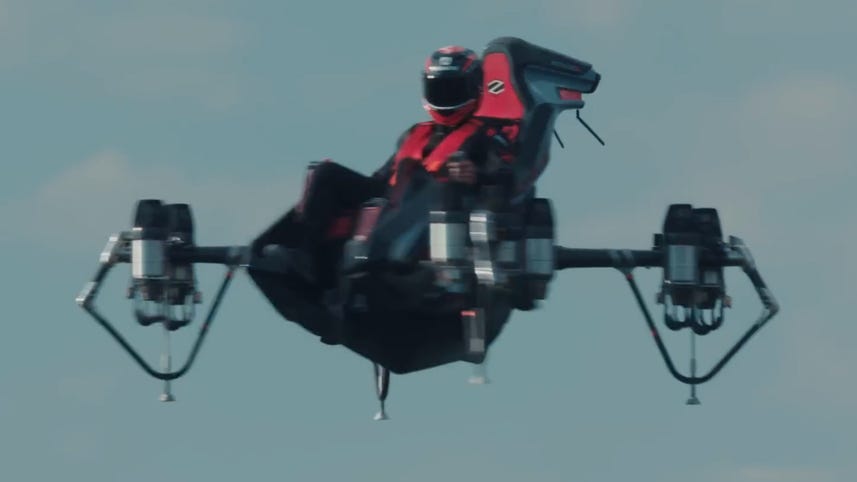
Speaker 1: Meet the one seat flying machine powered by 10 jet engines. It's called the Jet Racer. We spoke to the folks at Zapata, the company behind the Jet Racer, to learn more about how it works when you might get to fly one and what they're planning to make next. Let's get into it.
Speaker 1: You might already know the Zapata name from some of the extreme sporting and recreation devices they've invented, such as the Flyboard, easy Fly and Flyboard [00:00:30] Air. Now the company is using its experience making flying machines to work its way into mass transit. You can think of the Jet Racer as a bridge technology between zapata's recreational vehicles and the air mobility market. Let's start with some fast facts about this jet powered, barrel rolling flying machine. Its top speed is still being determined through testing and tweaking, but Zapata estimates it could be between 125 and 155 miles per hour. It's maximum altitude is similarly [00:01:00] yet to be determined, but Zapata's website says it imagines the jet racer being able to reach over 9,800 feet high and with 10 engines, Zapata says it can lose two and still fly.
Speaker 2: The machine has very strong capabilities, uh, which can be a bit intimidating when you look at it from for the first time. But flying it is actually super easy.
Speaker 1: That ease of flight is due to the Jet Racer's built-in flight controller, which automatically keeps the flying machine stable in a variety of weather conditions, prevents crashes [00:01:30] and makes autonomous flight a possibility. That's why Jet Racers flight control is this week's what the feature. One of the major challenges in selling air mobility is a mass transit solution is the reality that most people are not trained pilots. And even if they were, you've seen how some people drive. Do you really want road rage to go airborne? That's why most companies aiming at Urban Air Mobility have some sort of autonomous flight capabilities built in.
Speaker 2: As a pilot, you decide what [00:02:00] you want to do. So I want to go this way. I turn right, I will turn next. I wanna go down. I wanna go up. So you give input to the machine, but the machine decides how it's gonna do it. And no matter what you do, no matter if there is 80 kilometers wind, if you're giving crazy input to the machine, the machine will not let you crash. Literally, anybody can sit and fly it after receiving a minimal train.
Speaker 1: Zapata has demonstrated the flight controller's capabilities by programming it to do a barrel roll at the push of a button.
Speaker 2: It's a preconceived or pre-designed system. That [00:02:30] barrel roll, uh, is a good example of the, the inherent capabilities of the machine. What the machine is, is capable of doing if asked to.
Speaker 1: With its compact size and relatively short fly time, the jet racer's main use cases are imagined to be recreational, military, and perhaps in delivering personnel and goods to offshore operations like windmills that don't have much space to land On. About 25 people will get a chance to test pilot the jet racer in the United States. Eventually. Zapata plans to establish permanent flight centers [00:03:00] where the company's flying machines can be rented like a jet ski or an atv. Zapata is also working toward launching another flying machine, which will feature a hybrid electric and combustion engine and a longer flight time.
Speaker 2: 2023 is gonna be a big year for us in the, in the US especially. We are going to reveal our flight products, which is the scooter. It's going to be the year where we open, uh, our first place and just, uh, please look out for that and sign up for the jet experience and for your first flight, uh, with the later.
Speaker 1: As always, [00:03:30] thanks so much for watching. I'm your host, Jesse, or see you next time with the fam.